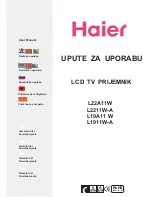
2
Important Safeguards
1.
Read Instructions
—All the safety and operating
instructions should be read before the appliance is
operated.
2.
Retain Instructions
—The safety and operating
instructions should be retained for future reference.
3.
Heed Warnings
—All warnings on the appliance and
in the operating instructions should be adhered to.
4.
Follow Instructions
—All operating and use
instructions should be followed.
5.
Cleaning
—Unplug the appliance from the wall out-
let before cleaning. The appliance should be cleaned
only as recommended by the manufacturer.
6.
Attachments
—Do not use attachments not recom-
mended by the appliance manufacturer as they may
cause hazards.
7.
Water and Moisture
—Do not use the appliance
near water –for example, near a bath tub, wash bowl,
kitchen sink, or laundry tub; in a wet basement; or
near a swimming pool; and the like.
8.
Accessories
—Do not place
the appliance on an unstable
cart, stand, tripod, bracket,
or table. The appliance may
fall, causing serious injury
to a child or adult, and seri-
ous damage to the appli-
ance. Use only with a cart,
stand, tripod, bracket, or table recommended by the
manufacturer, or sold with the appliance. Any mount-
ing of the appliance should follow the manufacturer’s
instructions, and should use a mounting accessory
recommended by the manufacturer.
9. An appliance and cart combination should be moved
with care. Quick stops, excessive force, and uneven
surfaces may cause the appliance and cart combina-
tion to overturn.
10.
Ventilation
—Slots and openings in the cabinet are
provided for ventilation and to ensure reliable opera-
tion of the appliance and to protect it from overheating,
and these openings must not be blocked or covered.
The openings should never be blocked by placing the
appliance on a bed, sofa, rug, or other similar surface.
The appliance should not be placed in a built-in instal-
lation such as a bookcase or rack unless proper ventila-
tion is provided. There should be free space of at least
8 in. (20 cm) and an opening behind the appliance.
11.
Power Sources
—The appliance should be operated
only from the type of power source indicated on the
marking label. If you are not sure of the type of
power supply to your home, consult your appliance
dealer or local power company.
12.
Grounding or Polarization
—The appliance may
be equipped with a polarized alternating current line
plug (a plug having one blade wider than the other).
This plug will fit into the power outlet only one way.
This is a safety feature. If you are unable to insert the
plug fully into the outlet, try reversing the plug. If the
plug should still fail to fit, contact your electrician to
replace your obsolete outlet. Do not defeat the safety
purpose of the polarized plug.
13.
Power Cord Protection
—Power-supply cords
should be routed so that they are not likely to be
walked on or pinched by items placed upon or
against them, paying particular attention to cords at
plugs, convenience receptacles, and the point where
they exit from the appliance.
14
. Outdoor Antenna Grounding
—If an outside
antenna or cable system is connected to the appli-
ance, be sure the antenna or cable system is grounded
so as to provide some protection against voltage
surges and built-up static charges. Article 810 of the
National Electrical Code, ANSI/NFPA 70, provides
information with regard to proper grounding of the
mast and supporting structure, grounding of the lead-
in wire to an antenna-discharge unit, size of ground-
ing conductors, location of antenna-discharge unit,
connection to grounding electrodes, and require-
ments for the grounding electrode. See Figure 1.
15.
Lightning
—For added protection for the appliance
during a lightning storm, or when it is left unattended
and unused for long periods of time, unplug it from
the wall outlet and disconnect the antenna or cable
system. This will prevent damage to the appliance
due to lightning and power-line surges.
16
. Power Lines
—An outside antenna system should
not be located in the vicinity of overhead power lines
or other electric light or power circuits, or where it
can fall into such power lines or circuits. When
installing an outside antenna system, extreme care
should be taken to keep from touching such power
lines or circuits as contact with them might be fatal.
WARNING:
TO REDUCE THE RISK OF FIRE OR ELECTRIC SHOCK,
DO NOT EXPOSE THIS APPLIANCE TO RAIN OR
MOISTURE.
CAUTION:
TO REDUCE THE RISK OF ELECTRIC SHOCK, DO NOT
REMOVE COVER (OR BACK). NO USER-SERVICEABLE
PARTS INSIDE. REFER SERVICING TO QUALIFIED
SERVICE PERSONNEL.
The lightning flash with arrowhead symbol, within an equilateral
triangle, is intended to alert the user to the presence of uninsulated
“dangerous voltage” within the product’s enclosure that may be of
sufficient magnitude to constitute a risk of electric shock to persons.
The exclamation point within an equilateral triangle is intended to
alert the user to the presence of important operating and maintenance
(servicing) instructions in the literature accompanying the appliance.
WARNING
RISK OF ELECTRIC SHOCK
DO NOT OPEN
RISQUE DE CHOC ELECTRIQUE
NE PAS
OUVRIR
AVIS
PORTABLE CART WARNING
S3125A
TX-8011̲E.book Page 2 Friday, July 30, 2004 10:33 AM



































